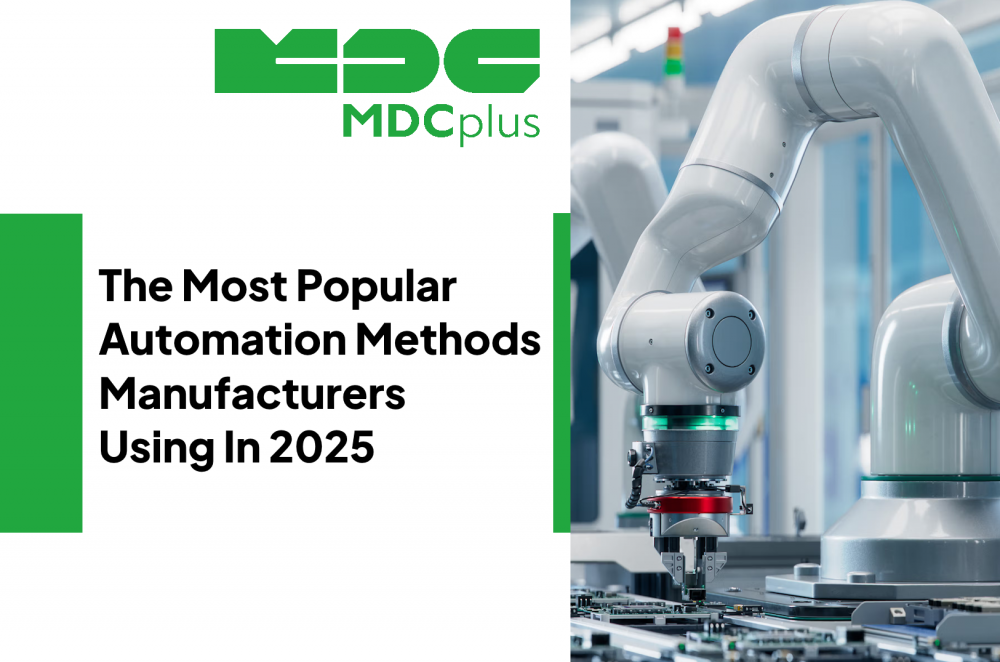The Most Popular Automation Methods Manufacturers Using In 2025
Automation isn’t new to manufacturing, but in 2025 it’s moving far beyond robotic arms and conveyor belts. Faced with global supply chain volatility, skills shortages, and tighter margins, manufacturers are leaning on a new wave of automation tools that don’t just replace manual work — they build resilience and efficiency into the entire production system.
1. Autonomous Mobile Robots (AMRs) for Material Handling
Forklifts and manual pallet jacks are steadily giving way to autonomous mobile robots. These robots navigate shop floors, staging areas, and warehouses with minimal human intervention. Why is it popular now? Labor shortages in logistics, plus the need for safer, leaner material flows - simple as that.
With reduced reliance on scarce forklift drivers, smoother production scheduling, fewer bottlenecks in intralogistics, Rockwell Automation’s PACK EXPO showcase highlighted OTTO AMRs integrated directly with MES systems, showing how material movement is no longer an isolated process but part of end-to-end automation.
2. Robotic Process Automation (RPA) in Back-Office and Production Planning
Automation isn’t only for machines on the shop floor. RPA software bots are increasingly used to handle repetitive digital tasks: updating ERP records, processing supplier invoices, generating compliance reports.
-
Why popular now: Administrative overhead drains time that manufacturers can’t afford when margins are thin.
-
Impact: Reduces clerical errors, accelerates data availability, and frees staff to focus on strategic work.
-
Trend: In 2025, more firms pair RPA with AI-driven decision support, allowing bots not just to execute workflows but to flag anomalies in purchasing or scheduling.
3. AI-Driven Quality Control
Vision systems combined with machine learning are now among the fastest-growing automation methods. Cameras check weld seams, paint finishes, or electronic assemblies in real time, learning to catch defects that humans miss.
-
Why popular now: Persistent pressure for higher quality with fewer skilled inspectors available.
-
Impact: Lower scrap rates, fewer recalls, and stronger customer trust.
-
Case in point: Automotive plants increasingly rely on AI vision to identify micro-defects in body panel welding that previously slipped past human inspection.
4. Predictive Maintenance and Automated Downtime Tracking
Instead of reactive maintenance schedules, predictive systems now automatically analyze vibration, temperature, and usage data from machines to forecast failures before they occur.
-
Why popular now: Unplanned downtime can cost automotive and electronics manufacturers tens of thousands of dollars per minute.
-
Impact: Extends machine life, reduces maintenance cost, and prevents catastrophic line stoppages.
Many plants are moving beyond simple monitoring to fully automated downtime categorization — no longer relying on manual operator logs to explain why a line stopped.
5. Digital Twins and Simulation Automation
Digital twins aren’t just engineering tools anymore. In 2025, they’re being used operationally to simulate production scenarios and automatically adjust parameters without waiting for trial-and-error on the floor - with rising material costs and tariff uncertainty make real-world mistakes too expensive.
Manufacturers in packaging and consumer goods industries are now simulating complete production lines virtually before rollout, saving weeks of testing, resulting in faster commissioning of new equipment, quicker response to demand shifts, and fewer wasted runs.
6. Collaborative Robots (Cobots) on the Line
Cobots continue to gain ground because they are flexible, safe, and scalable. Unlike traditional industrial robots locked in cages, cobots work alongside operators to handle repetitive or heavy tasks.
Flexible automation is critical when product mixes shift frequently, creating a reduced ergonomic risks for workers, increases throughput without major retooling, and boosts job satisfaction by moving people to higher-value tasks.
7. Automated Compliance and Traceability Systems
In highly regulated sectors like food, pharma, and aerospace, compliance workloads have exploded. Automated compliance systems now integrate with production data to log, verify, and report regulatory requirements in real time.
Regulatory change is constant and penalties are severe, and it's crucial to have less manual documentation, faster audits, and stronger trust with customers and regulators.
8. Integrated Energy and Resource Optimization
Energy prices and sustainability goals are pushing factories to automate resource management. Smart meters, IIoT sensors, and AI optimization models adjust energy loads, water use, and compressed air systems automatically.
Rising energy costs and ESG pressure puts utility expenses top priority while helping plants hit sustainability targets.
Automated demand-response systems that adjust production intensity to grid conditions in real time.
Automation as Strategy, Not Just Efficiency
What makes the 2025 wave of automation different is the strategic context. Manufacturers are not just automating to save labor costs — they are automating to build resilience. Whether it’s AMRs smoothing supply chain volatility, AI catching quality issues before they spread, or digital twins reducing risk from volatile demand, automation is becoming the foundation for operating in uncertainty.
The most competitive plants will be those that weave these automation methods together into an integrated ecosystem, rather than relying on isolated fixes. In a year where global factory activity is under pressure, automation has become less of a “nice to have” and more of a baseline for survival and growth.
About MDCplus
Our key features are real-time machine monitoring for swift issue resolution, power consumption tracking to promote sustainability, computerized maintenance management to reduce downtime, and vibration diagnostics for predictive maintenance. MDCplus's solutions are tailored for diverse industries, including aerospace, automotive, precision machining, and heavy industry. By delivering actionable insights and fostering seamless integration, we empower manufacturers to boost Overall Equipment Effectiveness (OEE), reduce operational costs, and achieve sustainable growth along with future planning.
Ready to increase your OEE, get clearer vision of your shop floor, and predict sustainably?
